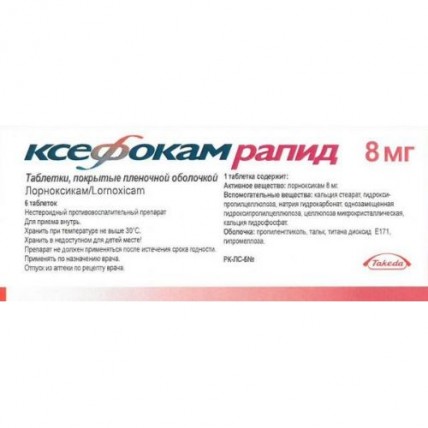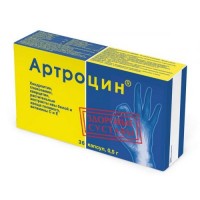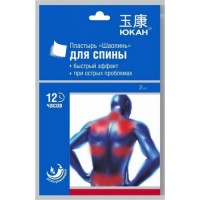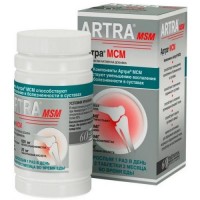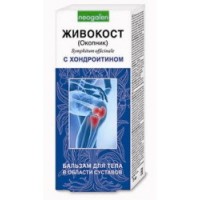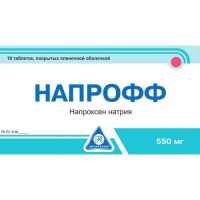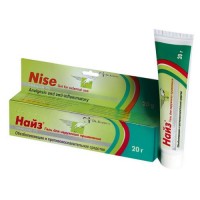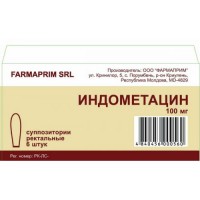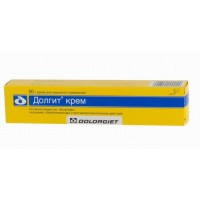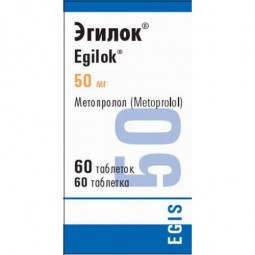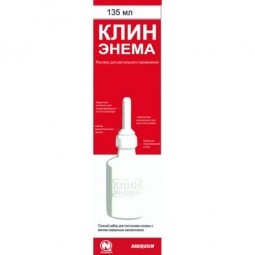Rapid Ksefokam 6's 8 mg coated tablets
- $7.30
The instruction for medical use of SLOW MOTION KSEFOKAM medicine the Trade name Ksefokam Rapid the International unlicensed name Lornoksikam Lekarstvennaya the Tablet form, film coated 8 mg Structure One tablet contains active agent - to lornoksika of 8 mg, excipients: calcium stearate – 1.6 mg, hydroxypropyl cellulose – 16 mg, Natrii hydrocarbonas – 40 mg, monosubstituted hydroxypropyl cellulose – 48 mg, cellulose microcrystalline – 96 mg, calcium hydrophosphate – 110.4 mg, structure of a cover: propylene glycol – about 1.1 mg, talc – about 3.6 mg, the titan dioxide (E171) – about 3.6 mg, a gipromelloz – about 5.7 mg. The description From white till light yellow color round, biconvex tablets, film coated. Pharmacotherapeutic group Anti-inflammatory and antirheumatic drugs. Non-steroidal anti-inflammatory drugs. Oksikama. Lornoksikam. The ATX M01AC05 code the Pharmacological Lornoksikam Pharmacokinetics properties is quickly and almost completely soaked up from the digestive tract (DT) after intake. At the same time the maximum concentration in plasma (Cmax) is reached approximately in 1-2 h Cmax of a lornoksikam above at administration of drug Ksefokam Rapid, than Cmax at administration of drug Ksefokam and is equivalent to Cmax for the dosage forms of a lornoksikam intended for parenteral administration. The absolute bioavailability Ksefokam Rapid of tablets is 90-100%. Average elimination half-life makes 3-4 hours. Lornoksikam is present at plasma in an invariable look and also in the form of a hydroxylated metabolite which has no pharmacological activity. Extent of linking with proteins of plasma makes 99% and does not depend on concentration. Lornoksikam is completely metabolized, about 2/3 is brought through a liver and 1/3 through kidneys in the form of inactive connection. It is removed with breast milk. At elderly people and at patients with abnormal liver functions and kidneys are not revealed significant changes of pharmacokinetics of a lornoksikam. The pharmacodynamics Lornoksikam represents non-steroidal anti-inflammatory drug (NPVP) with effective analgetic action. Oppression of synthesis of prostaglandins owing to the balanced oppression of activity of isoenzymes of cyclooxygenase-1 and cyclooxygenase-2 is the cornerstone of the mechanism of action of a lornoksikam. Besides, to lornoksika inhibits release of oxygen radicals from the activated leukocytes. Lornoksikam does not possess opiatopodobny action on the central nervous system and therefore breath does not oppress and also does not cause constipations and miotic effect. There are no bases also, to assume possibility at patients of medicinal dependence to a lornoksikam. Indications - for short-term simplification of an acute pain of light and moderate severity the Route of administration and doses Inside appoint 8-16 mg in doses. In the first day of treatment an initial dose of 16 mg, then 8 mg in 12 hours. Further appoint 8 mg 2 times a day. Maximum daily dose of 16 mg. The pill Ksefokama Rapid is taken inside before food, washing down with a glass of water. Side effects Often - a headache, dizziness - an abdominal pain, dyspepsia, nausea, vomiting, diarrhea Infrequently - anorexia, change of weight - insomnia, a depression - conjunctivitis - dizziness (vertigo), sonitus - heart consciousness, tachycardia. heart failure swell (peripheral and generalized) - rhinitis - a constipation, a meteorism, an eructation, dryness in a mouth, ulcers in an oral cavity - increase in level of hepatic transaminases, an abnormal liver function - rash, an itching, erythematic rash, a small tortoiseshell and a Quincke's edema, an alopecia, perspiration, hyperaemia - an arthralgia - an indisposition, a face edema Seldom - a melena, vomiting with blood, stomatitis, an esophagitis, gastritis, a gastroesophageal reflux. dysphagy - erosive cankers of a mucous membrane of a stomach and intestines, including with perforation and bleeding - aphthous stomatitis, a glossitis, pharyngitis, an asthma, cough, a bronchospasm - anemia, thrombocytopenia. a leukopenia, increase in a bleeding time - hypersensitivity, anaphylactoid reaction and an anaphylaxis - confusion of consciousness, nervousness, excitement, drowsiness, paresthesia, a tremor, migraine - disturbance of taste - a disorder of vision - a hypertension, inflows, bleeding, hematomas - an ostealgia, muscular spasms, myalgia - a nocturia, urination disturbance, increase in level of creatinine and urea nitrogen in blood serum - an asthenia - dermatitis and eczema, a purpura Very seldom - an ecchymoma, a neutropenia, an agranulocytosis, aplastic and hemolytic anemia - the aseptic meningitis arising mainly at patients with a system lupus erythematosus or the mixed diseases of connective tissue - a liver failure, hepatitis, jaundice, a cholestasia - an edematous syndrome, bullous reaction, Stephens-Johnson's syndrome, a Lyell's disease - an acute renal failure, interstitial nephrite, a nephrotic syndrome. Contraindications - hypersensitivity to a lornoksikam and auxiliary components of drug - instructions in the anamnesis on bronchial asthma, a small tortoiseshell and rhinitis - thrombocytopenia - hypersensitivity to other NPVP, including acetylsalicylic acid (such symptoms as asthma, rhinitis, a Quincke's disease or a small tortoiseshell), - heavy heart failure - gastrointestinal, cerebrovascular and other bleedings or suspicion of bleeding, fibrillation disturbance - a peptic ulcer of a stomach and duodenum in an aggravation phase, in the anamnesis of bleeding from a GIT, NPVP connected with reception - the profound liver failure - the profound renal failure (level of serumal creatinine & gt, 700 µmol/l) - children's and youthful age up to 18 years - the third trimester of pregnancy. Medicinal interactions At simultaneous use of a lornoksikam and: - Cimetidinum - concentration of a lornoksikam in plasma of blood increases, interactions with ranitidine and antiacid drugs it is not revealed, - anticoagulants or inhibitors of aggregation of thrombocytes - increase in a bleeding time and increase in risk of developing bleeding (control of the international normalized relation (INR) is necessary) is possible, - a fenprokumona: the efficiency of treatment fenprokumony, - heparin decreases: NPVP increase risk of developing of a spinal or epidural hematoma in case of simultaneous use with heparin at spinal or epidural anesthesia, - diuretics – the diuretic effect and hypotensive action - β-adrenoblockers and APF inhibitors decreases - their hypotensive effect can decrease, - digoxin – the renal clearance of digoxin decreases, - antithrombocytic drugs: the risk of developing of gastrointestinal bleedings increases, - other non-steroidal anti-inflammatory drugs and glucocorticoids - the risk of a GIT of bleedings increases, - hinolon - risk of development of a convulsive syndrome increases, - a methotrexate - concentration of a methotrexate in serum, - selective serotonin reuptake inhibitors increases (for example, a tsitaloprama, fluoxetine, a paroksetin, sertraline) - the risk of a GIT of bleedings increases, - lithium salts - increase in the maximum concentration of lithium in plasma and by that strengthening of the known side effects of lithium, - cyclosporine - nephrotoxicity of cyclosporine increases, - sulphonylurea derivatives - strengthening of hypoglycemic effect of the last is possible, - the known stimulators and inhibitors of an isoenzyme CYP2C9: to lornoksika (as well as other NPVP which are exposed to metabolism with CYP2C9 cytochrome participation) interacts with the known stimulators and to inhibitors of isoenzymes, - a takrolimusa: the risk of nephrotoxicity owing to weakening of synthesis of prostacyclin in kidneys increases. At such combination therapy it is necessary to control carefully function of kidneys, - the pemetrekseda - can decrease clearance of a pemetreksed, the Tablet Ksefokam Rapid, film coated, show the slowed-down absorption of a lornoksikam at reception together with food. Thus, the pill Ksefokam Rapid should not be taken at meal time when fast effective action (pain relief) is required. Food can lower absorption approximately by 20% and raise Tmax of a lornoksikam Special instructions in case of the following disturbances it is necessary to appoint drug only after careful assessment of the expected advantage of therapy and possible risk: – Lornoksikam patients should take with caution with a renal failure from easy (creatinine level in blood serum of 150-300 µmol/l) to moderate degree (level of plasma creatinine of 300-700 µmol/l) as maintenance of a renal blood-groove depends on the level of renal prostaglandins. Use of drug should be stopped in case of deterioration in function of kidneys during treatment. – Function of kidneys needs to be controlled at patients with extensive surgical intervention, with heart failure, at the same time accepting diuretics or funds with suspicion for ability to cause injury of kidneys or causing injury of kidneys. – Patients with fibrillation disturbance. It is recommended to make careful clinical observation and assessment of laboratory indicators (for example, partial thrombin time), – Patients with a liver failure (for example, cirrhosis). At patients with a liver failure it is regularly recommended to make clinical observation and assessment of laboratory indicators in connection with a possibility of accumulation of a lornoksikam in an organism (increase in AUC) after use of drug in a dose of 12-16 mg/days. For the rest, deviations of pharmacokinetic parameters at patients with a liver failure in comparison with healthy patients it is not revealed. – At long-term treatment (more than 3 months). It is recommended to carry out the assessment of a condition of blood (hemoglobin definition), functions of kidneys (creatinine definition) and liver enzymes, – Patients of advanced age (65 years are more senior). Observation of function of kidneys and a liver is recommended. With care to apply after surgical interventions. It is necessary to avoid simultaneous use of a lornoksikam with other NPVP, including with selection TsOG-2 inhibitors. Side effects can be minimized by means of reception of a minimal effective dose during the shortest span necessary for control of symptoms. At use of NPVP, cases of gastrointestinal bleedings, ulcers and perforation which can lead to a lethal outcome and which were noted at any time during treatment, with the warning symptoms either without those, or with cases of serious side effects from a GIT in the anamnesis were noted. The risk of developing of gastrointestinal bleeding, ulcer and perforation increases with increase in doses of NPVP at patients with an ulcer in the anamnesis, in particular, the complicated bleeding or perforation and at elderly people. At these patients it is necessary to begin treatment with the minimum dose. For patients who need such combination therapy and also for patients for whom the accompanying low dose of acetylsalicylic acid or other active agents which can increase risk of emergence of side effects from a GIT is necessary the treatment can be carried out against the background of a concomitant use of protective agents (for example, mizoprostol or inhibitors of a proton pomp). Regular clinical observation is recommended. Patients with cases of gastrointestinal toxicity in the anamnesis, in particular patients of advanced age, have to report about any unusual abdominal symptoms (in particular gastrointestinal bleedings), especially at the initial stages of treatment. It is recommended to observe precautionary measures at the patients accepting the accompanying medicines which can increase risk of forming of ulcers or bleeding, for example, oral corticosteroids, such anticoagulants as warfarin, selective serotonin reuptake inhibitors or such antithrombocytic means as acetylsalicylic acid. If gastrointestinal bleeding or an ulcer arises at the patients accepting to lornoksika, treatment needs to be stopped. NPVP should be given with care to patients with a gastrointestinal disease in the anamnesis (ulcer colitis, Crohn's disease) as their state can worsen. Drug should be used with care at patients with arterial hypertension and (or) heart failure in the anamnesis as it was reported about cases of developing of hypostases and delays of liquid in an organism owing to reception of NPVP. The corresponding observation and consultation are necessary in case of patients with hypertensia and/or stagnant heart failure from easy to moderate degree in the anamnesis as it was reported about cases of developing of hypostases and delays of liquid in an organism owing to reception of NPVP. The given clinical trials and epidemiological data demonstrate that some NPVP (especially in high doses and at long-term treatment) can be associated with the small increased risk of emergence of arterial thrombotic complications (for example, a myocardial infarction or a stroke). Insufficiency of data does not allow to exclude such risk on a lornoksikama. At patients with uncontrollable arterial hypertension, stagnant heart failure, an ischemic heart disease, atherosclerosis of peripheral arteries and (or) cerebrovascular disturbances and also before prolonged use at patients with risk factors of developing cardiovascular diseases (for example, hypertensia, a lipidemia, diabetes, smoking) treatment should be begun after the careful analysis. The accompanying use of NPVP and heparin increases risk of developing of a spinal/epidural hematoma at spinal or epidural anesthesia. At patients with bronchial asthma, including in the anamnesis, it is necessary to apply NPVP as cases of development of a bronchospasm were noted with care. At patients with a system lupus erythematosus and the mixed diseases of connective tissue the risk of developing aseptic meningitis increases. Lornoksikam suppresses aggregation of thrombocytes, increasing a blood clotting time. Patients should appoint drug with care with tendency to bleedings. The accompanying use of NPVP and takrolimus can increase risk of nephrotoxicity owing to weakening of synthesis of prostacyclin in kidneys. At such combination therapy it is necessary to control function of kidneys carefully. As well as in the majority of other NPVP at reception of a lornoksikam cases of incidental increase in level of transaminases, bilirubin in serum of blood or other indicators of hepatic function and also increase in level of creatinine in blood serum and urea nitrogen in blood and other deviations of laboratory indicators were noted. If the deviation of laboratory indicators essential or it remains long time, it is necessary to stop treatment and to conduct a necessary research. Lornoksikam, as well as other drugs suppressing synthesis of COG/of prostaglandin can weaken fertility, it is not recommended to apply at women who plan pregnancy. Cancellation of a lornoksikam should be considered for the women having problems with conception or undergoing inspection of fertility. In particular it is not necessary to use drug at patients with chicken pox as this disease can cause serious infectious complications of skin and soft tissues. Pregnancy and the period of a lactation Because of insufficient clinical experience it is not necessary to use the drug Ksefokam Rapid during pregnancy and feeding by a breast. Features of influence of medicine on ability to run the vehicle or potentially dangerous mechanisms. In case of developing of dizziness and/or drowsiness owing to administration of drug it is not necessary to run vehicles or to work with other mechanisms. Overdose Symptoms: nausea and vomiting, cerebral symptoms (the dizziness, an ataxy passing into a coma and spasms). Changes of function of a liver and kidneys, disturbances of blood clotting are possible. Treatment: it is necessary to stop drug intake, symptomatic treatment. Thanks to short elimination half-life, lornoksika it is quickly brought out of an organism. Lornoksikam is not exposed to dialysis. So far specific antidote is unknown. Reception and
tivirovanny coal right after reception Ksefokama Rapid can promote decrease in absorption of this drug. For elimination of the gastrointestinal disturbances caused by the drug Ksefokam Rapid it is possible to use an analog of prostaglandin or ranitidine. A form of release and packing On 6 tablets in blister strip packaging from PVC and aluminum foil. On 1 or 2 packs together with the instruction for medical use in the state, Russian and Azerbaijani languages place in a pack from cardboard. To Store storage conditions at a temperature not over 30 ºС. To store out of children's reach! A period of storage 2 years not to use drug after expiry date. Prescription status According to the prescription of Proizvoditel Takeda GmbH, Oraniyenburg, Germany the Holder of the registration certificate Takeda of Pharm of A/S, Denmark the Name and the country of the Takeda GmbH Oraniyenburg organization packer, Germany the Address of the organization accepting in the territory of the Republic of Kazakhstan claims from consumers on quality of products (goods) and responsible for post-registration observation of safety of medicine Representative office "Takeda Osteuropa Holding GmbH" (Austria) in Kazakhstan Almaty, Shashkin St. 44 Phone number (727) 2444004 Fax number (727) 2444005 The e-mail address of DSO-KZ@takeda.com the Address of the organization accepting in the territory of the Republic Azerbaijan of a claim from consumers on quality of products (goods) Representative office of "Takeda Osteoropa Holding GmbH" in Azerbaijan AZ 1141, Baku, A. Jamil St. 64/66 Phone number (994 12) 4473922 Fax number (994 12) 5101480
To develop
tivirovanny coal right after reception Ksefokama Rapid can promote decrease in absorption of this drug. For elimination of the gastrointestinal disturbances caused by the drug Ksefokam Rapid it is possible to use an analog of prostaglandin or ranitidine. A form of release and packing On 6 tablets in blister strip packaging from PVC and aluminum foil. On 1 or 2 packs together with the instruction for medical use in the state, Russian and Azerbaijani languages place in a pack from cardboard. To Store storage conditions at a temperature not over 30 ºС. To store out of children's reach! A period of storage 2 years not to use drug after expiry date. Prescription status According to the prescription of Proizvoditel Takeda GmbH, Oraniyenburg, Germany the Holder of the registration certificate Takeda of Pharm of A/S, Denmark the Name and the country of the Takeda GmbH Oraniyenburg organization packer, Germany the Address of the organization accepting in the territory of the Republic of Kazakhstan claims from consumers on quality of products (goods) and responsible for post-registration observation of safety of medicine Representative office "Takeda Osteuropa Holding GmbH" (Austria) in Kazakhstan Almaty, Shashkin St. 44 Phone number (727) 2444004 Fax number (727) 2444005 The e-mail address of DSO-KZ@takeda.com the Address of the organization accepting in the territory of the Republic Azerbaijan of a claim from consumers on quality of products (goods) Representative office of "Takeda Osteoropa Holding GmbH" in Azerbaijan AZ 1141, Baku, A. Jamil St. 64/66 Phone number (994 12) 4473922 Fax number (994 12) 5101480
To develop
